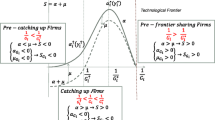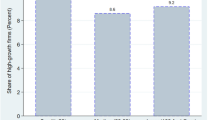Abstract
The absorptive capacity—the ability of enterprises to efficiently absorb and internalise knowledge from outside sources—represents the link between firms’ capabilities to implement new products and the external stock of technological opportunities, such as those gleamed from Multinational Enterprises (MNEs). This paper explores whether the effect of foreign direct investment (FDI) on the productivity of Italian domestically-owned firms (DOFs) is dependent on their absorptive capacity. In particular, given the peculiar characteristics of the Italian productive system, our analysis focuses on three different dimensions of the absorptive capacity: the size of the technological gap between foreign-owned firms (FOFs) and DOFs, firm size, and the regional distribution of firms. Our findings suggest that technological gap and firm size matter considerably for the spillover effect. Moreover, spillovers exhibit a sub-national dimension present only in the northeastern region of the peninsula.
Similar content being viewed by others
Notes
It is important to consider that productivity gains for domestic firms might be transmitted through the market mechanism (pecuniary externalities). Multinational entry may lead to a higher degree of competition which, as a result, might induce firms to reduce inefficiencies, and thus increase productivity. However, the increase in competition through FDI may also reduce the market share of domestic firms, which could reduce productivity in the presence of scale economies.
Where small firms have 1–49 employees, medium firms 50–249, large firms more than 250 employees.
The northwestern region includes Lombardy, Piedmont, Liguria and Valle d’Aosta; the northeastern region is composed of Friuli Venezia Giulia, Trentino Alto Adige, Veneto, and Emilia Romagna; the central region is composed of Tuscany, Marche, Lazio, Umbria, and finally the southern area includes Abruzzo, Molise, Campania, Calabria, Basilicata, Apulia, Sicily, and Sardinia.
References
Arundel, A., Smith, K., Patel, P., & Sirilli, G. (1998). The future of innovation measurement in Europe-Concepts, Problems and Practical Directions. IDEA Paper Series n. 03
Becattini, G. (1987). The market and local forces: The industrial district. Bologna: IL Mulino.
Blalock, G., & Gertler, P. (2008). Welfare gains from Foreign Direct Investment through technology transfer to local suppliers. Journal of International Economics, Elsevier, 74(2), 402–421.
Blomström, M., & Kokko, A. (1998). Multinational corporations and spillovers. Journal of Economic Surveys, 112, 247–277.
Blomström, M., & Wolff, E. N. (1994). In W. J. Baumol, R. R. Nelson, & E. N. Wolff (Eds.), Multinational corporations and productivity convergence in Mexico in Convergence of Productivity: Cross-National Studies and Historical Evidence (pp. 263–284). Oxford: Oxford University Press.
Brusco, S. (1986). Small firms and industrial districts - the esperience of Italy. In E. Wever & D. Keeble (Eds.), New firms and regional development (pp. 184–202). London: Croom Helm.
Cantwell, J. (1989). Technological innovation and multinational corporations. Oxford: Basil Blackwell.
Castellani, D., & Zanfei, A. (2007). Multinational companies and productivity spillovers: is there a specification error? Applied Economics Letters, 14, 1047–1051.
Cohen, W. M., & Levinthal, D. A. (1989). Innovation and learning: the two faces of R&D. The Economic Journal, 99, 569–596.
Cohen, W. M., & Levinthal, D. A. (1990). Absorptive capacity: a new perspective on learning and innovation. Administrative Science Quarterly, 35, 128–152.
Comanor, W. S., & Wilson, T. A. (1967). Advertising, market structure and performance. Review of Economics and Statistics, 49, 423–440.
Crespo, N., & Fontoura, M. P. (2007). Determinant factors of FDI spillovers-what do we really know? World Development, 35, 410–425.
Dimelis, S. (2005). Spillovers from foreign direct investment and firm growth: technological, financial and market structure effects. International Journal of the Economics of Business, 12, 85–104.
Driffield, N., Munday, M., & Roberts, A. (2004). Inward investment, transaction linkages and productivity spillovers. Papers in Regional Science, 83, 699–722.
Findlay, R. (1978). Relative backwardness, direct foreign investment and the transfer of technology: a simple dynamic mode. Quarterly Journal of Economics, 92, 1–16.
Flores, R. G., Jr., Fontoura, M. P., & Santos, G. S. (2007). Foreign direct investment spillovers in Portugal: additional lessons from a country study. The European Journal of Development Research, 19, 372–390.
Girma, S., & Wakelin, K. (2000). Are there regional spillovers from FDI in the UK? GEP research paper 00/16. Hamida: University of Nottingham.
Hamida, L. B., & Gugler, P. (2009). Are there demonstration-related spillovers from FDI? Evidence from Switzerland. International Business Review, 18, 494–508.
ICE (2010) L’Italia nell’economia internazionale – Rapporto ICE - 2009–2010.
Imbriani, C., & Reganati, F. (1999). Productivity spillovers and regional differences: Some evidence on the Italian Manufacturing Sector. Centro di Economia del Lavoro e di Politica Economica (CELPE), University of Salerno, Discussion Paper 48.
Imbriani, C., & Reganati, F. (2003). The Effects of Foreign Direct Investments on Local Firms. Some Evidence from Panel Data for the Italian Manufacturing Sector. Paper presented at the 2003 Hawaii International Conference on Social Sciences. June, 12–15.
Imbriani, C., & Reganati, F. (2004). The effects of foreign direct investment on local firms: some evidence from panel data for the Italian manufacturing sector. The Journal of Current Research in Global Business, 9, 18–24.
ISTAT (2008). Archivio Statistico delle Imprese Attive. Italian National Institute of Statistics.
ISTAT (2010a). Struttura e attività delle imprese a controllo estero - Anno 2008. Italian National Institute of Statistics.
ISTAT (2010b). L’innovazione nelle imprese italiane - Anni 2006–2008. Italian National Institute of Statistics.
ISTAT (2010c), Conti Economici Regionali, 1995–2009, Rome.
Jabbour, L., & Mucchielli, J. L. (2007). Technology transfer through vertical linkages: the case of the Spanish manufacturing industry. Journal of Applied Economics X, 115–136.
Jordaan, J. A. (2008). Intra- and inter-industry externalities from foreign direct investment in the Mexican manufacturing sector: new evidence from Mexican regions. World Development, 36, 2838–2854.
Kathuria, V. (2010). Does the technology gap influence spillovers? A post-liberalization analysis of Indian manufacturing industries. Oxford Development Studies, 38, 145–170.
Keller, W. (2009). International Trade, Foreign Direct Investment, and Technology Spillovers. NBER Working Papers 15442, National Bureau of Economic.
Kokko, A. (1994). Technology, market characteristics, and spillovers. Journal of Development Economics, 43, 279–293.
Levinsohn, J., & Petrin, A. (2003). Estimating production functions using inputs to control for unobservables. Review of Economic Studies, 70, 317–341.
Musca M. & Shilirò D. (2012). An investigation into medium-sized multinational enterprises. Munich Personal RePEc Archive MPRA Paper No. 43012. December 2012.
OECD (2009). Economic Surveys – Italy. Organisation for Economic Co-Operation and Development.
Olley, G. S., & Pakes, A. (1996). The dynamics of productivity in the telecommunications equipment industry. Econometrica, 64, 1263–1297.
Reganati, F., & Sica, E. (2007). Horizontal and vertical spillovers from FDI: evidence from panel data for the Italian manufacturing sector. Journal of Business Economics and Management, 8, 259–266.
Schilirò, D. (2011). Innovation and performance of Italian multinational enterprises of the “fourth capitalism”. Journal of Advanced Research in Management, II(2), 89–103.
Smarzynska, J. B. (2004). Does foreign direct investment increase the productivity of domestic firms? In search of spillovers through backward linkages. American Economic Review, 94, 605–627.
Spencer, J. W. (2008). The impact of multinational enterprise strategy on indigenous enterprises: horizontal spillovers and crowding out in developing countries. Academy of Management Review, 33, 341–361.
Takii, S. (2005). Productivity spillovers and characteristics of foreign multinational plants in Indonesian manufacturing 1990–1995. Journal of Development Economics, 76, 521–542.
Wang, Y., & Blomström, M. (1992). Foreign investment and technology transfer: a simple model. European Economic Review, 36, 137–155.
Zhang, Y., Li, H., Li, Y., & Zhou, L. A. (2010). FDI spillovers in an emerging market: the role of foreign firms’ country origin diversity and domestic firms’ absorptive capacity. Strategic Management Journal Early View, 31, 969–989.
Author information
Authors and Affiliations
Corresponding author
Additional information
Although this work was jointly conceived and produced by the four authors, “Introduction” section was written by Filippo Reganati, “Absorptive Capacity and FDI Spillovers” and “Estimation Strategy and Data Used” sections by Rosanna Pittiglio, “The Italian Case: Some Stylized Facts” and “Empirical Results and Interpretations” sections by Edgardo Sica, and “Conclusions” section by Cesare Imbriani.
Rights and permissions
About this article
Cite this article
Imbriani, C., Pittiglio, R., Reganati, F. et al. How Much do Technological Gap, Firm Size, and Regional Characteristics Matter for the Absorptive Capacity of Italian Enterprises?. Int Adv Econ Res 20, 57–72 (2014). https://doi.org/10.1007/s11294-013-9439-7
Published:
Issue Date:
DOI: https://doi.org/10.1007/s11294-013-9439-7




